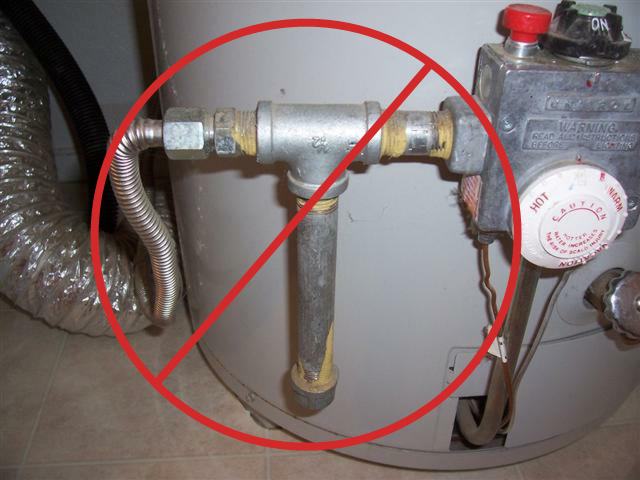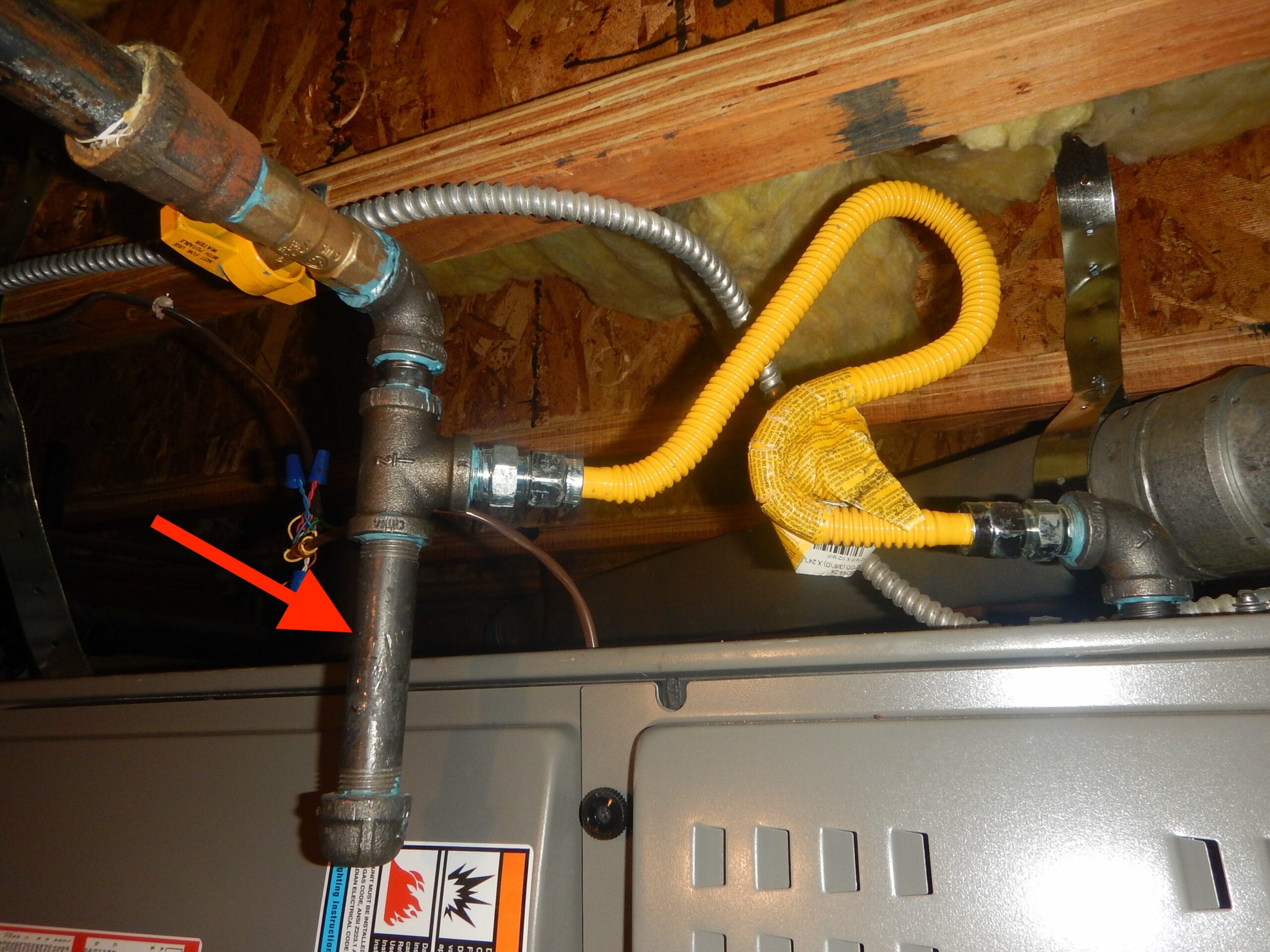If you have a gas line running to your home, it’s important to protect it from sediment buildup. One way to do this is to install a sediment trap. A sediment trap is a small cup-shaped device that sits inline with your gas line.
It collects any sediment that might be in the gas before it reaches your appliances. Here’s how to install one:
1. Turn off the gas at the main shutoff valve.
This is usually located near where the gas enters your home. If you’re not sure where yours is, call your utility company and they’ll help you locate it.
2. Cut the gas line using a tubing cutter or pipe saw so that there’s about 6 inches of space between the cut ends of the pipe.
Make sure both ends of the pipe are clean and free of burrs before proceeding.
3A. If you’re using a threaded connection type trap, thread one end of the trap onto each end of the pipe using two wrenches (one to hold the pipe steady and one to turn the trap).
- Locate the gas line running to your home and find a suitable location for the sediment trap
- Cut the gas line at the chosen location and fit a pipe tee into the newly cut end of the line
- Cut a length of pipe to connect the other end of the tee to an elbow fitting that will point downwards
- Solder or weld all fittings together and wrap them with thread-sealing tape or pipe dope
- Screw a cap onto the bottom-facing elbow to finish the sediment trap assembly
HOW TO INTALL SEDIMENT TRAP ON NATUARAL GAS HOT WATER HEATER
Where Do You Put a Sediment Trap on a Gas Line?
If you have a natural gas line in your home, it’s important to know where to put a sediment trap. A sediment trap is designed to catch any sediments or debris that might be in the gas line before it gets into your home. This can help prevent clogs and damage to your appliances.
The most common place to install a sediment trap is at the point where the gas line enters your home. This is usually near the meter or at the base of the main supply line. If you have an older home, there may not be a convenient place to install a sediment trap near the entrance of the gas line.
In this case, you’ll need to consult with a professional to find the best location for installation.
Are Sediment Traps Required on Gas Lines?
There are a variety of opinions on whether or not sediment traps are required on gas lines. Some believe that they are an essential safety measure, while others contend that they are unnecessary and can actually cause more problems than they solve. Here, we will take a look at the pros and cons of using sediment traps on gas lines to help you make an informed decision about what is best for your home or business.
Sediment traps are designed to catch any debris that might be carried along with the gas in the line. This can include things like dirt, rust, or even water. The trap is typically installed at the point where the gas line enters the building, before it reaches any appliances.
The idea is that by catching this debris before it gets into the appliances, it will reduce wear and tear on them and extend their lifespan. Additionally, it can prevent clogs in the gas line itself, which could lead to dangerous leaks.
One of the main arguments against using sediment traps is that they can actually create more problems than they solve.
If not properly maintained, sediment traps can become breeding grounds for bacteria or other contaminants. Additionally, if there is a blockage in the trap itself, it could cause pressure build-up in the gas line which could lead to leaks or explosions. Because of these potential risks, some experts recommend against using them altogether.
Ultimately, whether or not to use a sediment trap on your gas line is a decision that should be made based on your specific needs and circumstances. If you live in an area with high levels of contamination in the air or water supply, or if you have an old home with outdated plumbing, then a sediment trap may be a good idea. However, if you have newer plumbing and live in an area with relatively clean air and water supplies, you may be able to get by without one without any major issues.
How Long Should a Gas Line Sediment Trap Be?
A gas line sediment trap is a device that is installed in a gas piping system to help protect the system from contamination. The trap is designed to collect any sediment or debris that may be present in the gas before it reaches the appliances or other devices connected to the system.
The length of a gas line sediment trap can vary, depending on the size and layout of the gas piping system.
In most cases, the trap should be installed as close to the main shut-off valve as possible. This will help ensure that any sediment or debris collected by the trap does not enter into the rest of the piping system.
Are Dirt Legs Required on Gas Piping?
No, dirt legs are not required on gas piping. However, they may be installed on the piping to help protect against corrosion.

Credit: structuretech.com
Gas Sediment Trap Code
Most people are familiar with the idea of a sediment trap – it’s a device that is installed in a gas line to catch any sediment that might be carried along with the gas. Sediment traps are required by code in many jurisdictions, and for good reason: if sediment gets into your gas lines, it can clog up appliances and cause all sorts of problems.
Sediment traps typically consist of a small chamber with an inlet and outlet.
The inlet is connected to the gas line before any appliances, while the outlet goes to the appliances. As gas flows through the trap, any sediment falls out and collects in the bottom of the chamber. This prevents it from flowing on into your appliances.
Sediment traps need to be cleaned out periodically, depending on how much use they get and what kind of water quality you have in your area. You can do this yourself or hire a professional – but either way, it’s important to keep your trap clean so that your appliances stay safe and efficient.
Gas Sediment Trap Kit
Most gas fired appliances have a sediment trap (also called a dirt leg) installed before the gas valve. The purpose of the sediment trap is to collect any dirt, water or rust that may be in the gas line and keep it from getting into the appliance.
Sediment traps should be inspected periodically and cleaned out as needed.
If you have a sediment trap on your gas line, there’s a good chance that you’ll eventually need to clean it out. Fortunately, this is a relatively easy task that can be accomplished without calling a professional.
If you’re not familiar with how your appliance’s gas valve works, take a few minutes to familiarize yourself with it before attempting to clean out the sediment trap.
Once you know where the valve is and how to turn it off/on, you’re ready to get started.
1. Locate the sediment trap on your appliance’s gas line. It will typically be located near the base of the appliance (for example, near the floor for a water heater).
2. Turn off the power to your appliance at the breaker box. This will ensure that there’s no risk of electrocution while you’re working on the gas line.
3. Use an adjustable wrench to loosen and remove the nut that secures the flexiblegas line tothe valve .
This will give you access tothetrap itself .
4a . For most traps ,you can simply unscrewthe capanddumpoutthecontents .
Be sureto put somethingunderneaththesedimenttraptocatchanydirt or waterthatmay fall out whenyouremovethecap .
4b .Ifyourtrap has an automatic shut-offvalve ,you’ll needto use an allenkeyorhex keyto depress aclearingbuttonbeforeunscrewingthecap( otherwise ,gasmaybeginleakingfromtheline ).
Depressingthisbuttonwillrelease anypressurethatmay havebuiltupinsideofthetrapandallowyouto unscrewandremovethecapwithout issue .
5 .
Gas Sediment Trap Home Depot
If you’re looking for a quick and easy way to trap sediment in your gas line, look no further than your local Home Depot. For just a few dollars, you can purchase a gas sediment trap that will do the job perfectly. Simply install it inline with your gas line and watch as the sediment is trapped before it reaches your appliances.
This is an extremely affordable and effective way to keep your gas lines clean and free of debris.
Conclusion
If you have a gas line in your home, it’s important to install a sediment trap to prevent any sediment from getting into the line and causing problems. Here’s how to do it:
1. Turn off the gas at the main shutoff valve.
2. Disconnect the gas line from the appliance or devices it supplies.
3. Install the sediment trap according to the manufacturer’s instructions. Make sure that the arrow on the trap is pointing in the direction of flow (toward the appliances).
4. Reconnect the gas line and turn on the main shutoff valve slowly, then light any pilot lights as needed.


